
While the rest of the world was waiting with bated breath for the release of the new iPad, my company was focusing its efforts a very different direction: building a version of our app for Windows 8’s Consumer Preview, writes Roman Karachinsky.
We were cautious about this, as we’d built for the Windows 7 Phone, and initial adoption was undoubtedly disappointing. However, it looks like Microsoft is finally gaining ground in the mobile platform wars.
One thing is clear: this is a war that has yet to be won, and Microsoft may still have a fighting chance. Some are sceptical, but developing for Windows 8 has already proved to be the right decision for us. Here’s why.
1. The interface
We dedicate a lot of our time to working on our interface to create a better user experience that centres on our core offering (content). Microsoft’s designers had the same principles in mind.
Metro is clean, elegant, and appealingly spartan. It gets rid of all the “chrome” that usually hangs around the edges of each screen, and it hides everything but the most important control, which occupies the centre of your attention.
For developers, search, sharing and settings management are built into the platform and work across any app. At the base level, that frees your team up to focus more energy on the core value of your app, instead of having to reinvent the wheel yet again.
Of course, saving time wouldn’t be worth it if the platform didn’t offer a good user experience, but the share and search widgets are actually quite intuitive. Live tiles make notifications and pushing content easy and useful, and are absurdly simple to develop.
All of these provide a consistent and expected user interface. So, for example, anywhere you are, you can share what you’re looking at by swiping from the right edge of the screen and using the share charm. After a while you stop thinking about it, and the action becomes second nature , which leads to more people actually using these functions.
Additionally, all Metro navigation is accomplished with text links and simple square boxes, and developing the app within those constricting parameters gave us clarity about the best way to present data. Now we’re planning to use something similar across all of our tablet experiences to present large lists of stories to the user.
2. Cross-platform unification
This could be the thing that gives Microsoft the edge: it’s one platform that can be shared by phones, tablets, PCs and television. It makes for a better user experience and a truly unique one.
This was a draw for us. We knew that at the very least, we’d have tremendous reach thanks to all the PCs that would be automatically upgraded to Windows 8.
As one example of the cross-platform OS in action, PC users, mobile users and Xbox gamers will be able to play games together using different hardware as long as they have the same app. From a developer’s perspective, that means one code base gives you access to multiple audiences.
Microsoft still has to unify the Windows Phone Marketplace, Windows Store and Xbox Live into a single ecosystem, but once it does that, it’ll be an immensely powerful thing. The other platforms are also obviously moving in the same direction, but the huge penetration that Microsoft has in the PC and Xbox markets can give it a real edge in the “developer war”.
3. The audience
It goes without saying that when you design for a new platform, you have to take a leap of faith. To launch the Windows Store, Microsoft recruited hundreds of developers to build apps for the Consumer Preview. To get devs on board, Microsoft made the pitch that developing for Windows 8 would be different, and the potential audience reach would be larger than with any other platform.
Windows 8, once it launches, will most likely grow to be largest operating system. All the new PCs will have it preinstalled, and large numbers of existing PCs will be updated to it. Even without the new tablet devices, it will still ship by the hundreds of millions.
The fact that the Consumer Preview build was downloaded more than a million times in 24 hours after it came out is a good indicator of the kind of volume developers can expect out of the platform.
4. The Microsoft team
As a BizSpark One startup, we first met the Windows 8 team at the at the Build conference in September 2011, where Microsoft gave all of the participating developers a no-frills Samsung tablet (complete with a loud fan on the back) to start experimenting.
Over the course of a four-week development cycle, the Windows 8 team participated in weekly design and product reviews with us. We’d spend one or two hours on the phone with designers on their team every week, going through the features and making sure we were adhering to guidelines and learning about the best tools. Their team understood the nuances of their platform and helped us to create something that was useful and beautiful rather than simply converting our existing app.
5. It’s fun
We’ve created apps for pretty much all the platforms out there, and Windows 8 was one of the most fun projects we’ve done. The developer tools are amazing, the documentation is good and the frameworks are elegant and well designed, which means we could move very quickly with the implementation and have a running prototype with much of the required functionality just one week after first downloading the software development kit.
We could actually spend our time experimenting with the interface and making sure the app was awesome instead of battling obscure bugs (looking at you, BlackBerry WebWorks) or wasting time dealing with hardware fragmentation (you know who you are). All in all, it was a very positive experience for the team and we’re quite happy with the product that we ended up with. — VentureBeat![]()




